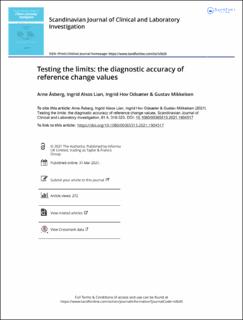| dc.contributor.author | Åsberg, Arne | |
| dc.contributor.author | Lian, Ingrid Alsos | |
| dc.contributor.author | Odsæter, Ingrid Hov | |
| dc.contributor.author | Mikkelsen, Gustav | |
| dc.date.accessioned | 2022-12-14T12:36:54Z | |
| dc.date.available | 2022-12-14T12:36:54Z | |
| dc.date.created | 2021-08-16T15:07:05Z | |
| dc.date.issued | 2021 | |
| dc.identifier.citation | Scandinavian Journal of Clinical and Laboratory Investigation. 2021, 81 (4), 318-323. | en_US |
| dc.identifier.issn | 0036-5513 | |
| dc.identifier.uri | https://hdl.handle.net/11250/3037705 | |
| dc.description.abstract | Reference change values (RCVs) are used by the physician to judge whether a change in analyte concentration from one sample to the next may represent a clinically significant change. Published RCVs are usually given as fixed percentages of the analyte concentration in the first sample. The accuracy of published RCVs is not well known. We obtained public-use data from the US National Health and Nutrition Examination Survey (NHANES) 2001–2002 to study the distribution of changes in the concentration of eight commonly used analytes. Specimens were obtained on two occasions 7–47 days apart from 279 to 411 individuals with an analyte concentration within the reference interval in both samples. The analytes were albumin, calcium, cholesterol, phosphate, potassium, sodium, hemoglobin and thrombocytes. For each analyte, normal within-subject biological coefficient of variation from the EFLM Working Group on Biological Variation and the NHANES analytical coefficient of variation were used to calculate the 5 and 95 percentile RCVs. These RCVs were calculated as fixed percentages of the analyte concentrations in the first sample and compared to the empirical 5 and 95 percentiles. The sensitivity of the RCVs in detecting changes outside the empirical percentiles ranged from 0.35 for sodium to 0.80 for albumin. The specificity of the RCVs in detecting changes inside the empirical percentiles ranged from 0.85 for potassium to 0.97 for thrombocytes. Calculating RCVs as fixed percentages of the analyte concentration in the first sample lessened the diagnostic accuracy. RCVs given as a function of the first result would perform better. | en_US |
| dc.language.iso | eng | en_US |
| dc.publisher | Taylor & Francis | en_US |
| dc.rights | Attribution-NonCommercial-NoDerivatives 4.0 Internasjonal | * |
| dc.rights.uri | http://creativecommons.org/licenses/by-nc-nd/4.0/deed.no | * |
| dc.title | Testing the limits: the diagnostic accuracy of reference change values | en_US |
| dc.type | Peer reviewed | en_US |
| dc.type | Journal article | en_US |
| dc.description.version | publishedVersion | en_US |
| dc.source.pagenumber | 318-323 | en_US |
| dc.source.volume | 81 | en_US |
| dc.source.journal | Scandinavian Journal of Clinical and Laboratory Investigation | en_US |
| dc.source.issue | 4 | en_US |
| dc.identifier.doi | 10.1080/00365513.2021.1904517 | |
| dc.identifier.cristin | 1926377 | |
| cristin.ispublished | true | |
| cristin.fulltext | original | |
| cristin.qualitycode | 1 | |

